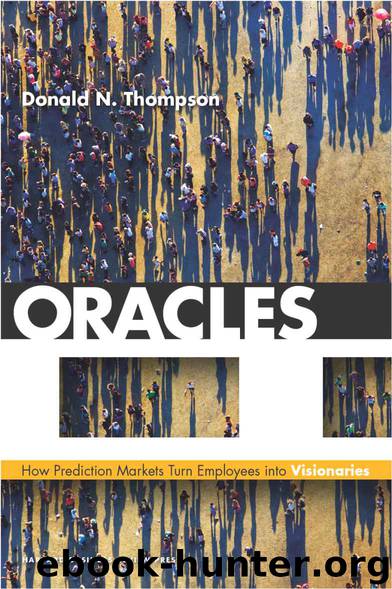Oracles: How Prediction Markets Turn Employees into Visionaries by Donald N. Thompson

Author:Donald N. Thompson
Language: eng
Format: mobi
Publisher: Harvard Business Review Press
Published: 2012-05-21T14:00:00+00:00
PART THREE
Where Can Markets Take Us?
11
Way-Outside-the-Box Markets
Casting Calls and Epidemiology
That rainbow song is no good. Take it out.
—MGM memo criticizing the first cut of the movie The Wizard of Oz, 1938
There will be one million cases of AIDS in Britain by 1991.
—World Health Organization 1989 report on the AIDS outbreak [actual 1991 count: 7,699]
THE PREDICTION MARKETS described in previous chapters reflect straightforward, in-the-box thinking; all that is required is application of the premise, “None of us is as smart as all of us.” But as with Google’s tracking of the Evanston tribe (chapter 7), there are applications that move outside the box, and might never have occurred to even an avid proponent of markets. These include casting a musical comedy, tracking epidemics, assessing the success of a program to raise reading scores of sixth-grade students, and selecting players for a renowned football team. Each is presented with the hope it may suggest to the reader even more creative applications.
How about casting a major stage production using a televised prediction exercise? In 2006, composer Andrew Lloyd Webber, creator of The Phantom of the Opera, Jesus Christ Superstar, and Evita, among others, used a London television audience in a multiweek talent series, How Do You Solve a Problem Like Maria? The goal was to identify the ideal Maria von Trapp to star in Lloyd Webber’s production of Rogers and Hammerstein’s classic The Sound of Music in London’s West End.
Lloyd Webber had first invited movie actor Scarlett Johansson to play the lead. This is a long-established way for a producer to create publicity and boost advance ticket sales: cast a celebrity and publicize the signing. But Johansson did not want to commit to live theater for a year when her movie career was taking off.
Using a television audience to judge talent had a previous and better-known application—the Fox TV hit American Idol. This singing competition allows viewers to vote by text message or telephone on the best singers and rockers. But Idol asks who viewers like most. The Sound of Music producers did not ask audiences to choose the best performer. Early in the program, Lloyd Webber described what audiences should look for: a woman who looked close in age to the eldest von Trapp daughter, could portray the innocence that characterizes Maria, and had a voice to fill a sixteen-hundred-seat theater. The role of Maria Augusta Rainer von Trapp, made famous by Mary Martin on stage and Julie Andrews on the screen, has been called the “biggest job on stage.”
Fifty candidates were chosen from three hundred who responded to an audition call. Thirty of the fifty had serious experience in musical comedy. Each week, a studio and television audience viewed several performances and voted off the candidates who were thought furthest from Lloyd Webber’s criteria. The voting process mimicked a prediction market. Each television viewer had up to six votes each week, through separate telephone calls. Since each call cost about £1 ($1.50), the casual viewer did not vote. Interested viewers might invest £1 each week in casting a single vote for their favorite.
Download
This site does not store any files on its server. We only index and link to content provided by other sites. Please contact the content providers to delete copyright contents if any and email us, we'll remove relevant links or contents immediately.
Hit Refresh by Satya Nadella(8854)
The Compound Effect by Darren Hardy(8508)
Change Your Questions, Change Your Life by Marilee Adams(7372)
Nudge - Improving Decisions about Health, Wealth, and Happiness by Thaler Sunstein(7242)
The Black Swan by Nassim Nicholas Taleb(6763)
Deep Work by Cal Newport(6563)
Daring Greatly by Brene Brown(6222)
Rich Dad Poor Dad by Robert T. Kiyosaki(6174)
Principles: Life and Work by Ray Dalio(5961)
Man-made Catastrophes and Risk Information Concealment by Dmitry Chernov & Didier Sornette(5646)
Playing to Win_ How Strategy Really Works by A.G. Lafley & Roger L. Martin(5499)
Digital Minimalism by Cal Newport;(5389)
Big Magic: Creative Living Beyond Fear by Elizabeth Gilbert(5351)
The Myth of the Strong Leader by Archie Brown(5237)
The Slight Edge by Jeff Olson(5200)
Discipline Equals Freedom by Jocko Willink(5157)
The Motivation Myth by Jeff Haden(5003)
Stone's Rules by Roger Stone(4857)
The Laws of Human Nature by Robert Greene(4773)
